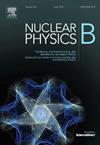夸克尼亚50年的个人记忆
IF 2.8
3区 物理与天体物理
Q2 PHYSICS, PARTICLES & FIELDS
引用次数: 0
摘要
1974年11月,J/ψ粒子的发现彻底改变了粒子物理学的世界,这是第一个被确定为由粲夸克和反夸克组成的夸克态的粒子。随后对相关c¯c态光谱的观测巩固了J/ψ的粲态解释,并最终在1976年发现了粲态粒子。在发现了夏蒙铵之后,1977年又发现了底onium介子和含有底夸克的粒子。顶夸克和反夸克的Toponium束缚态在原则上被预测存在,但是,在1995年顶夸克被发现之后,大多数物理学家认为,它的观测必须等到下一代e+e−对撞机的出现。然而,在2024年下半年,CMS合作报告了在大型强子对撞机中接近t¯t产生阈值的过量事件,这最有可能被解释为最低的toponium状态。这是一位目击者的个人回忆,他密切关注了夸克粒子发现的50年。本文章由计算机程序翻译,如有差异,请以英文原文为准。
Personal memories of 50 years of quarkonia
The world of particle physics was revolutionised in November 1974 by the discovery of the J/ψ particle, the first particle to be identified as a quarkonium state composed of charm quarks and antiquarks. The charmonium interpretation of the J/ψ was cemented by the subsequent observations of a spectrum of related states, and finally by the discovery of charmed particles in 1976. The discovery of charmonium was followed in 1977 by the discovery of bottomonium mesons and particles containing bottom quarks. Toponium bound states of top quark and antiquarks were predicted to exist in principle but, following the discovery of the top quark in 1995, most physicists thought that its observation would have to wait for a next-generation collider. However, in the second half of 2024 the CMS Collaboration reported an excess of events near the threshold for production at the LHC that is most plausibly interpreted as the lowest-lying toponium state. These are the personal recollections of an eyewitness who followed closely these 50 years of quarkonium discoveries.
求助全文
通过发布文献求助,成功后即可免费获取论文全文。
去求助
来源期刊

Nuclear Physics B
物理-物理:粒子与场物理
CiteScore
5.50
自引率
7.10%
发文量
302
审稿时长
1 months
期刊介绍:
Nuclear Physics B focuses on the domain of high energy physics, quantum field theory, statistical systems, and mathematical physics, and includes four main sections: high energy physics - phenomenology, high energy physics - theory, high energy physics - experiment, and quantum field theory, statistical systems, and mathematical physics. The emphasis is on original research papers (Frontiers Articles or Full Length Articles), but Review Articles are also welcome.
 求助内容:
求助内容: 应助结果提醒方式:
应助结果提醒方式:


